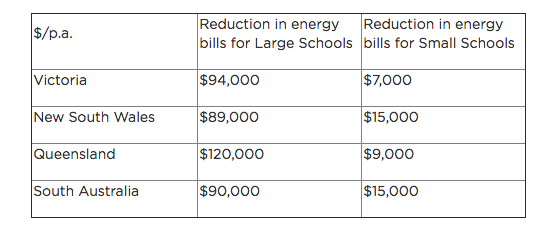From pv magazine Australia.
Australia’s federal Labor party has promised to make available up to $1 billion (US$704 million) from the government-owned Clean Energy Finance Corporation for the rollout of solar PV and batteries – benefiting up to 4,000 schools across the nation.
With Australia due to go to the polls on Saturday, May 18, Labor has outlined a plan for distributed energy systems to be linked into virtual power plants (VPPs) to deliver energy back to the grid – driving down electricity bills for consumers.
The party’s Solar Schools program, announced today, would provide concessional loans for the purchase of solar panels and battery systems, either by schools or VPP project developers. The full roll-out would support up to 364 MW of VPP capacity.
“Schools are an excellent location for solar investment and the creation of virtual power plants, because they often don’t use energy at times of peak demand, and through a large portion of summer,” Labor leader Bill Shorten said. “Schools are largely vacant for more than 150 days per year. Often demand for energy is highest when kids are not at school. This makes schools perfect locations for solar and battery-powered VPPs, to support grid reliability and lower power prices for Australian families and business.”
Major savings and benefits for the grid
Australian renewable energy association the Clean Energy Council (CEC) has conducted analysis suggesting the program would translate into major savings for schools. A typical smaller school could save $7,000-15,000 per year through the program, depending on location, electricity use and the terms of its power company contract. A larger school could save $89,000-120,000, the CEC calculated. The estimates do not include any additional revenue from the sale of power and other services to the grid.

The program would also improve grid reliability, according to the Labor leader.
“There will be particularly big benefits in December and January, when system reliability is under pressure due to demand spikes and unscheduled unit outages at ageing plants,” Shorten added.
Popular content
The party said two or three VPPs would initially be trialed in different regions. Different VPP models would be welcomed with the goal of fostering innovation and competition in VPP design and delivery. That would provide developers the freedom to choose equipment suppliers, aggregation services providers, retail partnerships and customer offerings.
The program would also be open to schools which already have solar panels and batteries, as they would be able to upgrade to newer or larger systems that would be better for self-consumption and participation in a VPP.
Strict requirements about product, installer and maintenance standards would be in place, said the Labor party. All installations would be undertaken by certified installers in compliance with the National Construction Code and the CEC installation guide. Batteries would have to meet the Australian Standard and CEC’s best practice guide, which requires certification against a range of international product standards.
Solar school initiatives
The program is part of Labor’s nationwide Energy Plan to deliver half of Australia’s energy from renewables by 2050. Today’s announcement followed the party’s pledge to encourage the uptake of household solar and battery systems by setting a target of one million household batteries by 2025 and by providing a $2,000 rebate for 100,000 households on incomes of less than $180,000 per year, to purchase and install batteries. The party has also promised low-cost loans for households.
Labor has pledged to raise investment in the Clean Energy Finance Corporation by $10 billion to support new generation and storage, concessional loans for household systems, commercial community renewables projects and the transformation and growth of industry.
“The $1 billion loan program announced by the ALP [Australian Labor Party] today would lead to a big increase in energy storage across the country, helping to improve the reliability of the energy system,” said CEC chief executive Kane Thornton, welcoming the Solar Schools program. “These systems are also a fantastic educational resource to give students a first hand glimpse at Australia’s move to renewable energy.”
Similar pledges have been made at state level. Last month’s New South Wales (NSW) election, which saw the incumbent Liberal-National Coalition administration re-elected, saw Labor outline a $100 million solar school program to help power around 350 schools in the state. That followed NSW government plans to spend $20 million to install up to 900 batteries in hospitals and schools that already had rooftop solar and to create a 13 MW virtual power plant.
In the Northern Territory, the Labor state government launched a $5 million Rooftop Solar in Schools program which aims to roll out PV on up to 25 schools over three years. And in Queensland, the Labor administration unveiled a $40 million solar program and $57 million worth of energy efficiency measures across 800 schools, through the Advancing Clean Energy Schools program.
This content is protected by copyright and may not be reused. If you want to cooperate with us and would like to reuse some of our content, please contact: editors@pv-magazine.com.



2 comments
By submitting this form you agree to pv magazine using your data for the purposes of publishing your comment.
Your personal data will only be disclosed or otherwise transmitted to third parties for the purposes of spam filtering or if this is necessary for technical maintenance of the website. Any other transfer to third parties will not take place unless this is justified on the basis of applicable data protection regulations or if pv magazine is legally obliged to do so.
You may revoke this consent at any time with effect for the future, in which case your personal data will be deleted immediately. Otherwise, your data will be deleted if pv magazine has processed your request or the purpose of data storage is fulfilled.
Further information on data privacy can be found in our Data Protection Policy.